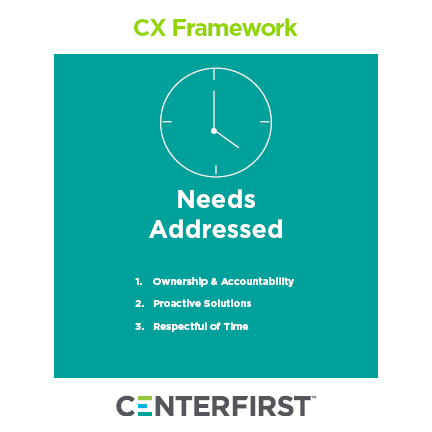Centerfirst CX Framework: Needs Addressed
Centerfirst’s CX Framework creates a foundation for contact centers to better understand where to focus their efforts to maximize the experience for their customers during live phone interactions. The CX framework has five components: Be Heard, Needs Addressed, Feel Confident, Be Informed, and Feel Included. In this blog we will be discussing the Needs Addressed component and its significance.
Customer experience is a culmination of interactions with a company. No matter the type of customer, we all want the same thing; for someone to help. Addressing a customer’s needs is at the forefront of every experience. When a customer seeks assistance from a company, they want to work with someone who understands their request and will take action.
The Needs Addressed component sets the tone for future interactions with a company; customers are more likely to publicize a negative experience vs a positive experience with others. If they don’t feel that their needs have been, or are not being met, it puts the company’s reputation at risk.

The components of Needs Addressed are:
- Ownership & Accountability: Being willing to do everything possible to solve customer’s problems, deliberating choices to take accountability, and reassuring customers by completely addressing their needs.
- Proactive Solutions: Solve future or potential problems by anticipating customer’s needs to go above and beyond expectations. Focus on what the customer ISN’T saying.
- Respectful of Time: Prioritize the customer’s needs and show them that their time is valuable by being thoughtful of the customer’s time by using organized and efficient responses.
A customer’s interaction with a company sets the tone for future communications and their opinion of a company. In the pharmaceutical world, if a patient doesn’t feel supported, they may seek out other medications (biosimilars) for treatment. Needs Addressed puts the patient first, resulting in positive branding and ongoing patient loyalty.
Shannon Catron, a Program Manager at Centerfirst, shares an example of what may happen if a customer isn’t listened to, disrespecting their time and leaving them frustrated.
“A caregiver calls the main product HUB hotline with a copay question but selects the wrong IVR prompt and is transferred to a Medical Information representative. The representative they reach transfers them to their Case Manager as they associate ‘copay’ with financial assistance. The Case Manager asks the caregiver the same probing questions as the Med Info representative and tells them they need to speak with a Copay Assistance representative (the call is transferred again). The caregiver is frustrated because 1) they had to repeat the reason for their call multiple times, 2) no one seemed to taking ownership or genuinely care about their problem, 3) they felt like they were being passed around and the representatives weren’t knowledgeable, 4) they didn’t feel their time was valued, and 5) they’d been on the phone for 20 minutes without an answer to a simple question.”

Focusing on this component is necessary to follow the steps of ownership, accountability, and action. Taking care of an issue; reassuring customers that their needs have been heard and that they’ll be met because they’ve called the right place and they are valued.
Read our full Centerfirst CX Framework white paper here.
If you are interested in learning more about this component of Centerfirst’s CX Framework, message us here.
